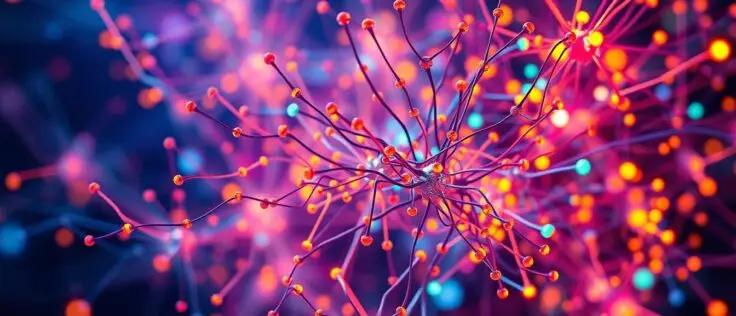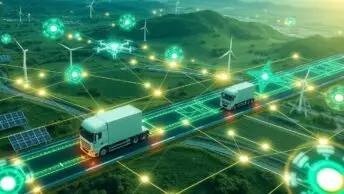If you’re new to neural networks, the tech might seem complex1. But learning about them helps you understand how AI works. There are plenty of resources to learn more. Websites like Reddit’s r/MachineLearning and books by experts like Ian Goodfellow are helpful. Big companies also offer tools like TensorFlow and PyTorch2.
Let’s discover how deep learning works. We’ll look at the basics and its real-world uses. This technology is not just advancing tech. It’s also changing how AI improves our lives3.
Introduction to the World of Deep Learning
The field of artificial intelligence has changed a lot because of deep learning. This use of artificial neural networks lets machines learn big amounts of data. So, they can do tasks like humans think and understand.
Deep learning is special as it has many hidden layers in its system. Each layer helps it to process information more deeply. Unlike simple models, deep learning ones with hundreds or thousands of layers do much better4.
The Emergence of Deep Learning in AI
Deep learning’s story started in the late 1980s and got big in 2006. That year, it changed artificial intelligence with new ways to learn and complex networks. Big tech companies like Google and Microsoft started using it a lot5.
Understanding the Basic Concepts
Deep learning works by understanding data in layers. Each layer adds more detail to the picture it’s building. This way of mimicking the human brain allows these networks to make decisions and spot patterns well.
Applications and Real-world Impact
Deep learning is used in many areas, making real changes. It improves things like healthcare’s visual tools and real-time translation devices. Schools are teaching more about it, showing its key role in tech’s future5.
To keep deep learning moving forward, we need to think about both the tech gains and its ethical use. To see how companies use AI to better connect with customers, check out AI-driven personalised recommendations.
What Makes Deep Learning Unique?
Deep learning stands out because it can change how we see data and improve technology. It uses deep neural networks to mimic the human brain’s complex workings. These networks can handle huge amounts of unstructured data, offering insights and reactions6.
The Architecture of Neural Networks
At the core of deep learning are deep neural networks. They have layers of connected nodes or neurons. These networks are good at spotting detailed patterns in data. Each neuron changes the data step by step, leading to better decisions. This structure is behind breakthroughs in image recognition and predictive analytics6.
From Data Processing to Predictive Analysis
In fields like healthcare and cars, deep learning is making prediction easier. For example, it helps find cancer cells accurately in medicine. In cars, it powers self-driving vehicles for safer driving7. These examples show deep learning’s wide use and its skill in making sense of real-world information7.
Deep Learning vs Traditional Machine Learning
Deep learning is different from older machine learning because it doesn’t need human help to select features. It digs deeper into data, learning and doing tasks by building complex data presentations. Also, it uses backpropagation to get smarter, reducing errors and boosting accuracy over time6. This ability to improve itself is what makes deep learning special6.
Deep Learning Explained: The Power of Neural Networks
Deep learning is all about neural networks, which act like our brains to tackle big data tasks. These include things like spotting what’s in a photo or translating languages8. Invented back in 1944, neural networks have grown stronger thanks to modern tech. Now, they can have up to fifty layers, which is why we call it “deep” learning89.
Neural networks are stars at finding patterns. This skill is key for both learning with a teacher, and learning on their own. By breaking down information layer by layer, they get to the heart of data. This helps machines make smart choices and guess what comes next9. They’re making our phones understand us better and are revolutionising healthcare with smarter diagnostic tools89.
Researchers are always finding new ways to make neural networks better. They’re solving old problems and exploring new possibilities, like stopping machines from making too many wrong guesses. The creation of simpler, smarter models has sped up progress in learning with and without a teacher8. Plus, exciting developments, such as GANs and transformers, are changing the game in understanding language and what computers can see9.
Enabling Machines to Learn: How Neural Networks Mimic the Human Brain
The growth of artificial intelligence owes much to neural networks. These are models that work like the human brain. They let machines learn from data and make decisions with little help from us. Neural networks use machine learning to deal with big and complex data sets. This way, they learn to do tasks by copying biological neurons.
Artificial Neurons and How They Function
At the heart of a neural network are artificial neurons. They act like human brain neurons. Each neuron gets input, processes it, and sends output to other neurons. This creates a learning network. AI algorithms make this process better. They help artificial neurons learn better and make the network more effective.
The Layers: Input, Hidden, and Output
Neural networks have three main parts: input, hidden, and output layers. The input layer takes in data, which hidden layers process in complex ways. Neural networks have layers including an input, hidden layers, and an output layer10. The heart of the action is in these layers. They use weights and biases to process info. This is key to deep learning, which is about having many layers.
The Role of Weights and Biases
In learning, weights and biases are vital. Weights help decide how much to consider an input. They change as the network learns. This is done using methods like gradient descent. This method helps reduce errors, making the network better10. Biases help adjust output to better match data. They fine-tune the network’s responses.
Neural networks do complex tasks better because of AI, artificial neurons, and machine learning basics. They are improving things like image and language processing. As they evolve, these models change many fields. They push forward machine learning and give us new insights into both tech and nature.
Preprocessing and Data Sets: Laying the Groundwork for Deep Learning
Data preprocessing and gathering strong data sets are key to successful deep learning. These initial steps are vital because they shape how well artificial neurons perform in AI algorithms. Preprocessing involves various methods that improve data quality, making it easier for neural networks to recognize patterns and learn effectively.
Data sets must be integrated and normalized to make sure everything is on the same scale. This prevents any feature from having too much influence. Issues like missing data and outliers are common in real-world data. They are fixed with advanced methods like imputation and Winsorization, keeping the model accurate11. Also, we need to change categorical data to numbers using methods like one-hot encoding11.
Feature engineering is crucial for enhancing AI model performance. Techniques like Principal Component Analysis (PCA) help by pulling out important features and reducing data complexity. This makes models simpler and more precise, especially with new data11. Good preprocessing means AI models train and make decisions faster, which is essential for tasks that happen in real-time11.
Improving data quality through preprocessing is key to a model’s success. A big chunk of time in engineering projects, about 60-70%, goes into preprocessing. This shows how important it is to have well-prepared data sets for neural networks. It lays a solid base for deep learning.
The careful processing of data sets and managing them well are crucial for deep learning. They matter not just in training but also show how committed an organisation is to effectively using AI. Putting effort into thorough data preprocessing boosts AI algorithm performance. It ensures that artificial neurons work in an ideal setup, leading to precise and scalable outcomes.
The Training Process of Deep Neural Networks
The architecture of deep neural networks is far from simple. They have over a hundred hidden layers12. These layers make it possible for the networks to grasp complex patterns. As technology grows, the way these networks are trained has also improved significantly. This allows them to tackle tasks like image recognition and driving cars without human help12.

Supervised and Unsupervised Learning Explained
In supervised learning, networks learn from datasets that are already labelled13. This helps them make predictions based on what they already know. Conversely, unsupervised learning lets the model find hidden patterns without any labels. It’s especially useful when it’s too hard for humans to label the data13.
Backpropagation: Fine-tuning Neural Connections
Achieving Accuracy through Iterative Learning
Navigating Common Pitfalls in Deep Learning
Deep Learning holds great promise but comes with challenges, such as overfitting. Models may memorise noise rather than learn real patterns. This makes it hard for them to work with new data, which is vital for AI in the real world15. To fight overfitting, use methods like regularization and dropout. These help simplify the model and improve its performance on unfamiliar data15.
Refining deep learning models also involves using gradient descent algorithms properly. They are key in reducing the cost function, essential for training networks. Yet, setting their parameters wrong can mess up learning. Getting the tuning right is crucial to keep training stable across the network’s layers16.
Functions like sigmoid or ReLU add crucial non-linearity to neural networks’ decisions. But, picking the wrong function can cause vanishing gradients. This issue makes learning hard for the network. Choosing the right activation functions is key to strong training outcomes16.
Fixing these problems means more than just adjusting algorithms. It involves understanding how to apply models strategically. For example, when integrating AI into business, it’s critical to evaluate models carefully and compare them fairly1516. Companies must use thorough evaluation methods to ensure their AI can grow and adapt, providing reliable insights for strategy1516.
In summary, succeeding with deep learning isn’t just about technological skill. It requires careful planning, a solid grasp of core algorithms like gradient descent, and smart tactics to avoid overfitting. Adding strong, flexible activation functions ensures models are effective and scalable, meeting specific business needs16.
Exploring Various Deep Learning Models
The frontier of AI grows rapidly, introducing models that tackle unique challenges across areas. These models show us the power and use of different deep learning frameworks. They change industries like healthcare and finance in big ways.
Convolutional Neural Networks: Visual Pattern Recognition
Convolutional Neural Networks (CNNs) shine at understanding complex visuals. They can spot faces in crowds or find issues in medical images. This is because they learn the best features for tasks on their own.
They are very effective in areas like healthcare, online shopping, and safety. Their skills in spotting images, finding objects, and recognising faces are top-notch17.
Recurrent Neural Networks: Understanding Sequence Data
Recurrent Neural Networks (RNNs) are great with data that follows a sequence. They can predict what word comes next or what the weather will be like. RNNs remember past inputs to make sense of new ones. This method helps them understand information in order.
Generative Adversarial Networks: The Creative Side of AI
Generative Adversarial Networks (GANs) are at the forefront of AI creativity. They can make new data that looks just like the real thing. From art to new drugs, GANs’ creativity is vast. They make realistic images and videos that are hard to tell from real ones17.
As industries move towards smart systems, the importance of CNNs, RNNs, and GANs grows. They not only handle huge amounts of data but also meet new challenges. This takes us closer to systems that can work on their own.
The Role of Activation Functions in Neural Networks
Activation functions are vital in neural networks. They provide needed non-linearity, without which the network would act like a linear regression model. Functions like sigmoid, ReLU, and their types help neural networks to learn complex patterns well.
Incorporating Non-linearity with Sigmoid and ReLU
The sigmoid function changes smoothly from one state to another with an S-shaped curve. It outputs values between 0 and 1. This is useful when predicting probabilities, especially in classifications where being near 1 or 0 shows a strong belief in the outcome20.
ReLU is preferred in deep learning for its simple way to add non-linearity. It passes only positive values and turns negatives to zero. This method tackles the vanishing gradient problem, making training smoother20.
Selecting the Right Activation Function
Choosing the right activation function is crucial for a neural network’s success. Sigmoid functions work well for binary classification, giving outputs between 0 and 1. However, they might not suit complex models due to possible learning halts from extreme gradients2122. ReLU and its variations, like Leaky ReLU, keep neurons actively learning by allowing a small, positive gradient even when inactive. This solves the dying ReLU issue20.
Impact on the Network’s Learning Capability
The activation function choice hugely influences network learning and abilities. Non-linear functions like ReLU, tanh, and sigmoid allow the network to grasp complex inputs. This brings necessary depth and complexity to the model22.
Each function, like tanh with its zero-centered outputs, offers distinct benefits. This particular trait helps optimise the model during backpropagation by keeping data normalised. It speeds up convergence20. The application context of each activation function is key in neural architecture and deep learning progress.
Deep Learning in Action: Case Studies and Applications
Deep learning has changed many fields, like how we see and understand our world. It’s behind major advancements in things like computer vision and self-driving cars. For example, convolutional neural networks (CNNs) are key in computer vision. They make it possible for computers to recognize images in ways that improve everything from tagging photos online to medical diagnostics23. These networks can handle huge amounts of visual data far better than old methods. This shows how deep learning is top-notch when it comes to recognising complicated patterns23.
Natural language processing (NLP) also gets a big boost from recurrent neural networks (RNNs). RNNs are great at dealing with sequences, which helps machines understand and generate human language better. This leads to improvements in translation, voice recognition, and writing text that feels more natural23. Similarly, self-driving cars depend on deep learning to get around safely. They process loads of information from sensors and cameras, using deep reinforcement learning to navigate tricky situations without human help23.
Deep learning isn’t just about the usual stuff; it’s also making waves in special areas like materials science. Here, it’s opening up new possibilities for exploring materials in ways we couldn’t before24. Plus, in drug discovery and studying proteins, deep learning powers predictive models. These models help speed up creating new medicines and getting them to people quicker24.
However, using deep learning can be tough. Issues like needing big datasets, the risk of overfitting, and bias in the data call for more research and clever solutions24. Despite these hurdles, the advantages, like uncovering intricate patterns and being able to scale, make deep learning a popular choice in many areas23.
In summary, deep learning’s effect is immense in fields like computer vision and natural language processing. It significantly outperforms older methods. As this technology develops, it promises to make even bigger contributions to science and tech.
The Future and Advancements in Deep Learning Technologies
Deep learning continues to grow, changing how we use technology and data. Looking ahead, merging AI algorithms with new tech and solid AI education is key. This blend is vital for unlocking AI’s full power in diverse fields.
Challenges and Opportunities in AI Education
AI Education is facing two big challenges. It needs to expand for higher demand and keep up with new tech breakthroughs. Innovations like attention mechanisms are improving how computers understand us. These advancements will soon improve how they see and hear us too25.
In the EU, strict AI laws are expected soon. This means AI training must also teach future experts how to work with these laws25. Adding deep learning to courses could make AI a key part of future breakthroughs in all areas.
Emerging Trends: AI Algorithms and Their Implications
The AI algorithm world is rapidly changing. Deep learning leads this change. Tools like GPT-4 and BERT have already changed how machines understand language26. Also, federated learning is making data privacy and security better by training models over many devices26. These changes are making AI more ethical, secure, and effective. They promise an AI future that is both strong and trusted.
Integrating Deep Learning into Various Industry Sectors
Deep learning is more than just research. It’s offering real solutions in many sectors. In healthcare, it’s making patient care better by predicting outcomes more accurately27. In finance, it’s changing how businesses understand risk and deal with customers27. These uses show that as we get to know machine learning better, AI’s role in boosting efficiency and innovation gets bigger25.
Conclusion
Deep learning is an amazing part of machine learning, sitting under the wide umbrella of artificial intelligence28. It uses neural networks, similar to how our brains work, to make significant advances in AI2829. These networks learn and get better on their own by going through a lot of data. They don’t need us to pick apart the data manually28.
As we look closer, we find that deep learning is part of a tech evolution. It moves us closer to devices that can solve problems and make decisions like we do29.
The joining of AI and education on AI is paving the way to a bright future. It’s making it more likely for us to use neural networks across different areas2829. With help from deep learning, we have new tools. Like voice and picture recognition, they create solutions tailored to us. This happens in health checks and in banking29. AI is playing a crucial role. It is changing how humans and machines work together. This change is based on learning from data28.
It’s crucial to keep pushing forward with AI education. This ensures more people can use and improve these technologies28. By sharing knowledge about neural networks and deep learning, we’re building a future. This future will have smart systems as part of our daily lives. For more on how AI is changing learning and business, like making marketing better and engaging customers, one can check out AI for lead generation. This highlights how AI can enhance sales processes28.
FAQ
What is Deep Learning and how does it differ from traditional Machine Learning?
Deep learning is a branch of machine learning. It uses neural networks with many layers. These layers act like the human brain. Unlike traditional machine learning, deep learning can make sense of data through complex networks. This lets it spot patterns and make predictions. Traditional methods use less complex algorithms and not as many layers.
What are neural networks in the context of deep learning?
Neural networks are at the heart of deep learning. They consist of nodes or neurons linked together. Just like our brains, they spot patterns and make choices. They have layers of neurons that go from input to output. This setup helps them handle complicated tasks well.
How does backpropagation work in neural networks?
Backpropagation helps adjust connections between neurons. It starts by finding errors at the output. Then, it spreads these errors back through the network. This helps adjust the connections to make fewer mistakes. It’s a key part of how neural networks learn.
What is the difference between supervised and unsupervised learning in deep learning?
Supervised learning uses data that’s already sorted into categories. It helps the model learn from examples with known answers. Unsupervised learning doesn’t have these categories. It lets the model find patterns on its own. Both ways are important for teaching deep neural networks.
What role do activation functions play in neural networks?
Activation functions help decide if a neuron should turn on or off. They make neural networks capable of learning complicated patterns. They bring non-linearity to the process. Sigmoid, tanh, and ReLU are common examples. Each one is useful in different scenarios.
Why is data preprocessing important in deep learning?
Data preprocessing gets data ready for neural networks. It cleans, normalises, and organises data. This makes sure the network can find patterns well. Good preprocessing improves a model’s performance. It does this by providing clean and structured data for training.
Can you explain overfitting and how it can be prevented in deep learning?
Overfitting happens when a model learns from noise, not the real pattern. It does well on training data but badly on new data. To prevent it, you can use regularization or dropout layers. Reducing the model’s complexity also helps.
What are some of the key types of deep learning models and their uses?
Many deep learning models serve different purposes. CNNs work well for images. RNNs are good with sequential data, like speech. GANs create new data similar to their training set. This is useful for making new images or changing image styles.
What industries are benefiting from the advancements in deep learning technologies?
Deep learning is changing many fields. Healthcare uses it for diagnosing diseases. Finance uses it to spot fraud. It’s helping cars drive themselves and online shops offer personal suggestions. These technologies improve decision-making, automate processes, and provide predictive insights.
How is AI education relevant to the advancement of deep learning?
AI education is key for pushing deep learning further. It teaches people about deep learning, neural networks, and basic machine learning. Better AI education grows the talent pool. This allows for more innovation and better solutions across different sectors.
Source Links
- Demystifying Deep Learning: A Beginner’s Guide to Neural Networks – https://www.linkedin.com/pulse/demystifying-deep-learning-beginners-guide-neural-networks-khalid-7fese?trk=public_post
- Demystifying Deep Learning: A Comprehensive Beginner’s Guide – https://megasisnetwork.medium.com/demystifying-deep-learning-a-comprehensive-beginners-guide-4c568810ebb0
- Demystifying Deep Learning: A Beginner Guide- iLeaf Solutions – https://www.ileafsolutions.com/demystifying-deep-learning-a-beginners-guide
- What Is Deep Learning? | IBM – https://www.ibm.com/topics/deep-learning
- Deep Learning: A Comprehensive Overview on Techniques, Taxonomy, Applications and Research Directions – SN Computer Science – https://link.springer.com/article/10.1007/s42979-021-00815-1
- What is deep learning and how does it work? | Definition from TechTarget – https://www.techtarget.com/searchenterpriseai/definition/deep-learning-deep-neural-network
- What is Deep Learning? – Deep Learning Explained – AWS – https://aws.amazon.com/what-is/deep-learning/
- Explained: Neural networks – https://news.mit.edu/2017/explained-neural-networks-deep-learning-0414
- Deep Learning: Unleashing the Power of Neural Networks in AI – https://www.linkedin.com/pulse/deep-learning-unleashing-power-neural-networks-ai-srivastava–jfwbc
- What is a Neural Network? | IBM – https://www.ibm.com/topics/neural-networks
- The Role of Data Preprocessing in Machine Learning – https://skillfloor.medium.com/the-role-of-data-preprocessing-in-machine-learning-d9ad9db54d49
- Deep Neural Network (DNN) Explained – https://medium.com/@zomev/deep-neural-network-dnn-explained-0f7311a0e869
- Deep learning – https://en.wikipedia.org/wiki/Deep_learning
- Neural networks learning process explained – https://medium.com/@thecybermarty/neural-networks-learning-process-explained-a555d29bf214
- PDF – http://arxiv.org/pdf/2108.02497
- Key concepts, common pitfalls, and best practices in artificial intelligence and machine learning: focus on radiomics – https://www.ncbi.nlm.nih.gov/pmc/articles/PMC9682557/
- Top 10 Deep Learning Algorithms You Should Know in 2024 – https://www.simplilearn.com/tutorials/deep-learning-tutorial/deep-learning-algorithm
- Interpreting Deep Learning Models: Techniques for Understanding Predictions – https://medium.com/@zhonghong9998/interpreting-deep-learning-models-techniques-for-understanding-predictions-470b521ec401
- The Ultimate Guide to AI Models (2024) – viso.ai – https://viso.ai/deep-learning/ml-ai-models/
- Activation Functions in Neural Networks [12 Types & Use Cases] – https://www.v7labs.com/blog/neural-networks-activation-functions
- Activation functions in Neural Networks – https://www.geeksforgeeks.org/activation-functions-neural-networks/
- Activation Functions in Neural Networks – https://towardsdatascience.com/activation-functions-neural-networks-1cbd9f8d91d6
- What is Deep Learning? – https://cloud.google.com/discover/what-is-deep-learning
- Recent advances and applications of deep learning methods in materials science – npj Computational Materials – https://www.nature.com/articles/s41524-022-00734-6
- Deep Learning and Neural Networks: The Future of Machine Learning – https://online.nyit.edu/blog/deep-learning-and-neural-networks
- Future of Deep Learning: Trends and Emerging Technologies – https://www.linkedin.com/pulse/future-deep-learning-trends-emerging-technologies-devfiinc-rxzec
- Deep Learning: Types, Use Cases and Future Projections – https://blog.bismart.com/en/types-of-deep-learning
- What Is Deep Learning and How Does It Work? | Built In – https://builtin.com/machine-learning/deep-learning
- Deep learning vs. machine learning – https://www.zendesk.com/blog/machine-learning-and-deep-learning/






